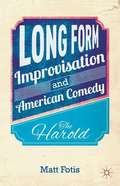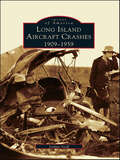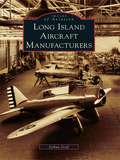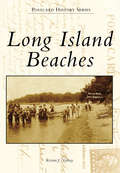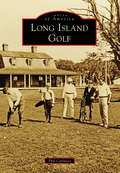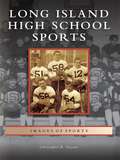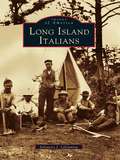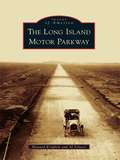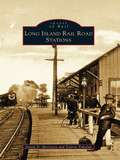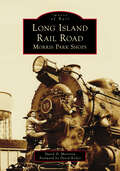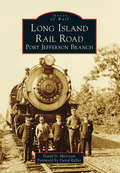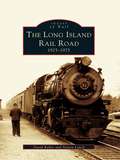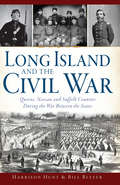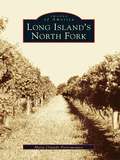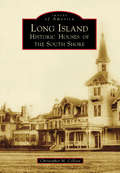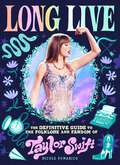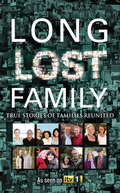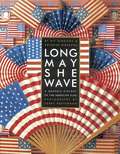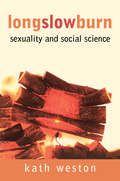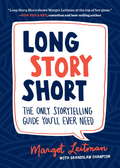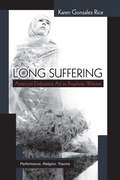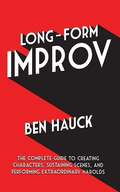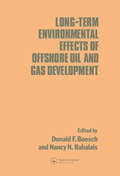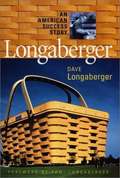- Table View
- List View
Long Form Improvisation and American Comedy
by Matt FotisLong form scenic improv began with the Harold. The comic philosophy of this form started an era of comedy marked by support, trust, and collaboration. This book tells of the Harold, beginning with the development of improv theatre, through the tensions and evolutions that led to its creation at iO, and to its use in contemporary filmmaking.
Long Island Aircraft Crashes: 1909-1959
by Joshua StoffDuring the first fifty years of American aviation, Long Island was at the center of aircraft innovation and flight. There were more aircraft manufacturers and airports located on Long Island than in any other part of the United States. Due to the extraordinarily high volume of air traffic, Long Island also led the country-if not the world-in aircraft crashes. Long Island Aircraft Crashes: 1909-1959 portrays the daring flights, accidents, and mishaps of pioneer pilots, and the conditions that contributed to many crashes. Long Island ultimately saw the earliest air-traffic control systems, airport lighting, aviation weather reports, paved runways, and professional flight schools. Long Island Aircraft Crashes: 1909-1959 contains captivating images from Mitchel Field and Roosevelt Field, the two most active airfields on Long Island. In addition to airfield activity, this book illustrates some of the first experimental flights over Hempstead Plains; military training at Hazelhurst Field; the L.W.F. Owl bomber (the largest landplane of its time); the world's first instrument-guided flight; and Amelia Earhart posing with the new Sperry Gyropilot.
Long Island Aircraft Manufacturers (Images of Aviation)
by Joshua StoffSignificant aircraft manufacturing began on Long Island in the early 20th century and boomed during the war years. Long Islanders helped transform aviation from a dangerous sport to a viable means of transportation, while also producing a large portion of the nation's aerial arsenal in times of war. From the first frail biplanes to the warbirds of World War II and the sleek fighters of the jet age, aviation companies on Long Island helped make aviation the integral part of our world that it is today. During the 20th century, over 70 firms came to build aircraft on Long Island. Some of these firms lasted for decades and became famed builders of historic aircraft, such as Grumman, Republic, Curtiss, Fairchild, and Sikorsky.
Long Island Beaches (Postcard History Series)
by Kristen J. NyitrayFor centuries, Long Island's beaches have provided sustenance, relaxation, and inspiration. The coastline is renowned for its sandy Atlantic Ocean surf beaches, calm bayfront beaches, and rugged north shore Long Island Sound beaches. First inhabited by Native Americans, the area was called Sewanhacky ("Isle of Shells") in reverence to the offerings received where the water met the land. Drawing from the archives of local libraries, historical societies, museums, and private collections, Long Island Beaches presents a curated selection of vintage postcards illustrating the diversity of Nassau and Suffolk Counties' beautiful shores. Rare photographs and maps accompany the postcards to provide historical context. Through extensive research, author Kristen J. Nyitray documents a facet of Long Island's social and cultural history and the lure of its picturesque beaches.
Long Island Golf (Images of America)
by Phil CarlucciWhen the European sport of golf found its way to Long Island and took root in the Hamptons at Shinnecock Hills in 1891, its journey across the Atlantic served as the opening drive of a recreational era that now spans three centuries. Home to more than 130 golf courses, the area boasts prestigious American clubs overlooking picturesque Atlantic bays and inlets, along with public layouts climbing and descending the region's sloping terrain. Long Island is home to the most popular municipal golf facility in the country, the centerpiece of which is Bethpage Black, "the People's Country Club." Celebrated architects like A.W. Tillinghast, Devereux Emmet, Seth Raynor, and C.B. Macdonald built many of Long Island's famous courses, which have challenged the brightest of golf's stars. International tournaments and star-studded exhibitions have all been decided on Long Island turf, helping it grow into one of the world's most prominent golf settings.
Long Island High School Sports (Images of Sports)
by Christopher R. VaccaroFor nearly 120 years, Long Island has fielded high school sports teams. In that span, numerous local athletes rose to the highest level, dynasties were built, legends were made, and the nation's largest island was filled with captivating athletic stories and sports lore that will live forever. Long Island High School Sports strings together a pictorial history of Long Island's oldest, most famous, and well-respected teams, coaches, and athletes.
Long Island Italians (Images of America)
by Salvatore J. LaguminaIn America "the streets were paved with gold." That was the mistaken notion of many an immigrant to the United States in the late 1800s and early 1900s. On Long Island, deluded sojourners from Italy were to find that in fact there were few streets and that they themselves were to be the ones to build them.Covering more than a century of history, Long Island Italians depicts the transition of urban Italians as they moved increasingly from the city to the suburbs in Nassau and Suffolk Counties. They were attracted to Long Island by economic opportunity, the availability of arable land, home ownership possibilities, and alternatives to harsh city life. There, they became the largest of all ethnic groups, with more Americans of Italian descent living in one concentrated area than anywhere besides Italy. The Italian American presence is a continuing phenomenon, today comprising about 25 percent of the total population of Long Island. Long Island Italians graphically illustrates that Italian laborwas vital to the development of Long Island roads, agriculture, railroads, and industry. By the early twentieth century, Italians made up the bulk of the work force. The book goes beyond the laborers to show also the warmth of Italian family life, the strength of the social organizations, and the rise of the politicians.
Long Island Motor Parkway, The (Images of America)
by Howard Kroplick Al VelocciA forerunner of the modern highway system, the Long Island Motor Parkway was constructed during the advent of the automobile and at a pivotal time in American history. Following a spectator death during the 1906 Vanderbilt Cup Race, the concept for a privately owned speedway on Long Island was developed by William K. Vanderbilt Jr. and his business associates. It would be the first highway built exclusively for the automobile. Vanderbilt's dream was to build a safe, smooth, police-free road without speed limits where he could conduct his beloved automobile races without spectators running onto the course. Features such as the use of reinforced concrete, bridges to eliminate grade crossings, banked curves, guardrails, and landscaping were all pioneered for the parkway. Reflecting its poor profitability and the availability of free state-built public parkways, the historic 48-mile Long Island Motor Parkway closed on Easter Sunday, April 17, 1938.
Long Island Rail Road Stations
by David D. Morrison Valerie PakalukChartered in 1834 to provide a route between New York City and Boston, the Long Island Rail Road ran from the Brooklyn waterfront through the center of Long Island to Greenport. The railroad served the agricultural market on Long Island until branches and competing lines eventually developed on the north and south shores of the island and several hundred passenger stations were built. After Penn Station was opened in 1910, the number of passengers commuting between Manhattan and Long Island began to multiply. Today, one hundred twenty-five stations serve the Long Island Rail Road. Long Island Rail Road Stations contains vintage postcards of the old Penn Station, which was demolished in the mid-1960s; the Grand Stairway at the Forest Hills Station, where Theodore Roosevelt delivered his famous unification speech on July 4, 1917; and the Amagansett station building, where Nazi spies boarded a train bound for New York City on June 13, 1942. Many of the historic stations featured in this book have been preserved by local preservation groups, while others have been replaced with modern buildings to accommodate the passengers who commute on the nation's largest commuter railroad.
Long Island Rail Road: Morris Park Shops (Images of Rail)
by David D. MorrisonDavid D. Morrison, retired Long Island Rail Road (LIRR) branch line manager and railroad historian, has compiled rare photographs to showcase the shops that power the LIRR, the busiest railroad in North America. The LIRR provides passenger rail service from Midtown Manhattan to to the far ends of Long Island at Greenport and Montauk. A vast operation such as this requires a huge fleet of locomotives and cars. The reliability of the fleet rests mainly upon the shop maintenance facility. The Morris Park Shops, opened in 1889 and closed in the early 2000s, provided over a century of maintenance and repair service, allowing the LIRR to develop and expand through the years. The complexity of the shop facility, from the days of steam locomotives to multiple-unit electric cars and diesel locomotives, is a fascinating chapter in LIRR history.
Long Island Rail Road: Port Jefferson Branch
by David Keller David D. MorrisonThe Long Island Rail Road is the oldest railroad in the country still operating under its original name. As the busiest railroad in North America, it carries 265,000 customers each weekday aboard 735 trains on 11 different branches. The Port Jefferson Branch serves 10 stations from Hicksville to Port Jefferson and carries nearly 20 percent of the railroad's passenger traffic over its 32 miles of track. Hicksville Station is the site of the October 8, 1955, "End of Steam Ceremony," when steam locomotives were retired from service. The oldest surviving station building constructed by the Long Island Rail Road is on this branch at St. James. Between 1895 and 1938, the branch extended 10 miles east to Wading River. The branch was not electrified until 1970 and that was only to Huntington Station, east of which is served by diesel and dual-mode locomotives.
Long Island Railroad, The: 1925-1975
by David Keller Steven LynchChartered on April 24, 1834, as a route from Brooklyn to Boston, the Long Island Rail Road commenced in 1836 with service between Brooklyn and Jamaica, New York. The railroad has linked Long Island and New York City through several periods of increasing immigration and population beginning in the 1880s. Farmers and fishermen have depended on the railroad for their livelihood, and every summer thousands of tourists flock to Long Island beaches on the Long Island Rail Road. It is still the nation's largest commuter railroad, transporting an average of over two hundred fifty thousand commuters daily. The Long Island Rail Road: 1925-1975 offers a behind-the-scenes look at freight and passenger activities and the people who worked on the railroad. These one-of-a-kind photographs depict structures no longer in use, such as towers, water tanks, and crossing shanties, as well as electric motive power and other facets of a working railroad.
Long Island and the Civil War: Queens, Nassau and Suffolk Counties During the War Between the States (Civil War Series)
by Harrison Hunt Bill BleyerAlthough no battles were fought on Long Island, the Civil War deeply affected all of its residents. More than three thousand men--white and black--from current-day Queens, Nassau and Suffolk Counties answered the call to preserve the Union. While Confederate ships lurked within eight miles of Montauk Point, camps in Mineola and Willets Point trained regiments. Local women raised thousands of dollars for Union hospitals, and Long Island companies manufactured uniforms, drums and medicines for the army. At the same time, a little-remembered draft riot occurred in Jamaica in 1863. Local authors Harrison Hunt and Bill Bleyer explore this fascinating story, from the 1860 presidential campaign that polarized the region to the wartime experiences of Long Islanders on the battlefield and at home.
Long Island's North Fork (Images of America)
by Maria Orlando PietromonacoBoasting a verdant landscape and miles of silky white beaches, Long Island's North Fork remains a natural paradise. Escaping the urbanization that overspread much of Long Island in the early 1900s, the rural villages survived on farming, fishing, shipbuilding, and maritime trading. Loyal residents have preserved the North Fork's rich heritage and tranquil pace of life. Thus, agriculture still thrives and boats continue to cruise the crystal-clear waters.Long Island's North Fork explores the past through the eyes of those who lived in the rustic countryside. It is a treasury of photographs, many taken by professionals, others from selected family albums and collections.
Long Island: Historic Houses of the South Shore (Images of America)
by Christopher M. ColloraIn contrast to and predating Long Island's famous Gold Coast (the North Shore), communities along the Great South Bay were home to hundreds of less publicized, yet equally impressive, mansions and historic houses. These homes were once owned by prominent captains of industry, popular entertainment figures, and movers and shakers of the day, such as the Bourne, Cutting, Gardiner, Gulden, Gustivino, Guggenheim, Hollins, and Vanderbilt families. Long Island: Historic Houses of the South Shore explores the South Shore's famous resident personalities, including Schuyler Parsons, Fred Astaire, Anita Stewart, and Robert Pinkerton. The lifestyle of the South Shore is also portrayed, including activities like hunting and fishing as well as the famous beaches that served as tourist attractions.
Long Live: The Definitive Guide to the Folklore and Fandom of Taylor Swift
by Nicole PomaricoThis lushly illustrated package is the ultimate fan guide for Swifties! It covers the Taylor Swift multiverse from all angles with a journey through fandom history, exclusive interviews, and behind-the-scenes detail on her career across eras, including The Tortured Poets Department. Whether you&’ve been with Taylor from the start or are a new fan, this guide is for you. Use it to catch up on all the lore and inside jokes from the beginning, or to discover forgotten details from the past. From MySpace comments to T-Party invites to Secret Sessions and beyond, Long Live explores the evolution of Taylor as well as the ride that fans have been on with her through two decades of personal milestones—hers and ours, both good and bad. With Long Live you&’ll: Take a trip through Taylor&’s eras from the start of her career, with stops at each album and its iconic songs, the hidden Easter Eggs, and relationships that have informed the star&’s music. Have fun looking back on concert traditions and inside jokes, roll your eyes at the most embarrassing clowning moments, take in era-specific Swiftie style lessons, read exclusive stories of fan encounters and author Nicole Pomarico&’s own experiences meeting Taylor Swift and her parents. Be amazed by how the relationship between Taylor and her fans has been so well nurtured that it has become a cultural force building the career of one of the biggest stars of all time. Featuring stylish illustrations and photos throughout, this is an essential look at the artist&’s career and fandom. The complete package for Taylor Swift fans!
Long Lost Family: True stories of families reunited
by Humphrey PriceHosted by Davina McCall and Nicky Campbell, Long Lost Family has been a huge ratings success for ITV1 during the Spring of 2011, winning huge audiences of between 4.5 and 5 million during its 6-part run in April and May 2011. The programme was instantly re-commissioned, and Series 2 is due to be broadcast in Spring 2012. The show helps relatives - some of whom have been searching in vain for many years - to find the family members they are desperately seeking. It explores the background and context of each family's estrangement and reveals the detective work and complex and emotional process of finding each lost relative before they are reunited. It is tear-jerking stuff. This brilliant new book takes the very best emotional stories from the show and expands on them to tell these wonderfully warm and poignant tales in all their heartstring-tugging glory. It also contains a section of hints and tips for how to go about starting a search for a long lost family member. The perfect gift for Mother's Day.
Long Lost Family: True stories of families reunited
by Humphrey PriceHosted by Davina McCall and Nicky Campbell, Long Lost Family has been a huge ratings success for ITV1 during the Spring of 2011, winning huge audiences of between 4.5 and 5 million during its 6-part run in April and May 2011. The programme was instantly re-commissioned, and Series 2 is due to be broadcast in Spring 2012. The show helps relatives - some of whom have been searching in vain for many years - to find the family members they are desperately seeking. It explores the background and context of each family's estrangement and reveals the detective work and complex and emotional process of finding each lost relative before they are reunited. It is tear-jerking stuff. This brilliant new book takes the very best emotional stories from the show and expands on them to tell these wonderfully warm and poignant tales in all their heartstring-tugging glory. It also contains a section of hints and tips for how to go about starting a search for a long lost family member. The perfect gift for Mother's Day.
Long May She Wave: A Graphic History of the American Flag
by Kit Hinrichs Delphine Hirasuna Gerard C. WertkinFrom one of the world's leading graphic designers comes a stunning tribute to America's most enduring icon-the Stars and Stripes.The Revolutionary Congress resolved in 1777 that "the flag of the United States be 13 stripes, alternate red and white, that the Union be 13 white stars in a blue field representing a new constellation." Since that time, the American flag has been raised high in wartime triumph and peacetime celebration; burned in fervent protest; sewn lovingly onto quilts, caps, pillows, and bags; appropriated by the commercial sphere to sell goods as varied as cigars, and designer clothing, and rock-and-roll albums; and faithfully honored every 4th of July to celebrate America's independence. This collection of more than 3,000 Stars and Stripes artifacts ranges from Civil War-era banners and Native American braided moccasins to an early 20th-century "friendship" kimono and original flag art by several of the world's leading designers. In its deluxe format with over 500 illustrations, LONG MAY SHE WAVE gives wide berth to the flag in all its manifestations, and the result is a stunning visual history of America'¬?s most treasured symbol.Full-color throughout, with over 500 illustrations in a deluxe 11 x 14-inch volume-LONG MAY SHE WAVE is the perfect gift for folk-art appreciators, history buffs, and collectors.Features the 3,000-piece exhibit that was displayed at the American Institute of Graphic Arts and the San Jose Museum of Art in 2000. From toy soldiers to collectable spoons, cigar blankets to historic flags-the breadth of the collection is unrivaled.For a list of appearances by this author, check out our Calendar of Events.
Long Slow Burn: Sexuality and Social Science
by Kath WestonKath Weston's powerful collection of essays, Long, Slow Burn, challenges the preconception that queer studies is the brainchild of the humanities and argues that social science has been talking about sex all along. To deny this one would have to overlook Kinsey's pioneering sex research in the 1950s, or the psychiatrist Evelyn Hooker's pathbreaking study of homosexuality, but also in the "sex talk" that lies at the heart of classic debates on kinship, inequality, cognition, and other foundational topics in the social sciences. What is different now, Weston claims, is the way sexuality has been isolated from other contemporary issues. Not content with its ghettoization as a contained subfield, Weston refuses to draw an artificial line around sexuality.
Long Story Short: The Only Storytelling Guide You'll Ever Need
by Margot LeitmanThis is a practical storytelling guide from comedian, winner of multiple Moth storytelling competitions, and founder of the Upright Citizens Brigade storytelling program, Margot Leitman. Did you ever wish you could tell a story that leaves others spellbound? Storytelling teacher and champion Margot Leitman will show you how! With a fun, irreverent, and infographic approach, this guide breaks a story into concrete components with ways to improve content, structure, emotional impact, and delivery through personal anecdotes, relatable examples, and practical exercises.From the Trade Paperback edition.
Long Suffering: American Endurance Art as Prophetic Witness
by Karen Gonzalez RiceLong Suffering productively links avant-garde performance practices with religious histories in the United States, setting contemporary performances of endurance art within a broader context of prophetic religious discourse in the United States. Its focus is on the work of Ron Athey, Linda Montano, and John Duncan, American artists whose performances involve extended periods of suffering. These unsettling performances can disturb, shock, or frighten audiences, leaving them unsure how to respond. The book examines how these artists work at the limits of the personal and the interpersonal, inflicting suffering on themselves and others, transforming audiences into witnesses, straining social relations, and challenging definitions of art and of ethics. By performing the death of self at the heart of trauma, strategies of endurance signal artists' attempts to visualize, legitimize, and testify to the persistent experience of being wounded. The artworks discussed find their foundations in artists' early experiences of religion and connections with the work of reformers from Angelina Grimké to Rev. Martin Luther King, Jr., who also used suffering as a strategy to highlight social injustice and call for ethical, social, and political renewal.
Long-Form Improv: The Complete Guide to Creating Characters, Sustaining Scenes, and Performing Extraordinary Harolds
by Ben HauckLong-Form Improv deftly teaches the wildly popular form of improvisation that is so foundational to the comedy stylings of many of today's top actors and thriving comedians. Crammed with innovative ideas for conceptualizing improvised scenework and "finding the game of the scene," this crisply written manual covers techniques for experienced improvisers, curious actors, and even non-actors. A complete long-form improv resource comprising topics like ideation and character creation, improvising scenes for extended periods of time and enhancing them--and even performing the most famous expression of long-form improv, the half-hour improvised form known as "The Harold"--this astute text is written in a friendly, supportive voice by an experienced improv teacher and professional actor whose own frustration in learning the craft drove an obsession to create a program free of confounding teachings and contradictory concepts. The book's groundbreaking infusion with drama theory and game theory brings new life to the teachings of the craft, breaking down various aspects of long-form improv into short chapters for swift, step-by-step intake of its vital lessons. Students of acting and long-form improv alike should expect Long-Form Improv to bolster their education and fast-track their course to improv greatness.
Long-term Environmental Effects of Offshore Oil and Gas Development
by Donald F. Boesch Nancy N. RabalaisLong-term Environmental Effects of Offshore Oil and Gas Development contains 14 chapters by different authors which focus on the US.
Longaberger: An American Success Story
by Robert L. Shook David H. LongabergerDave Longaberger was one of the most remarkable entrepreneurs of his generation. His vision, his unorthodox business methods, and his belief in people resulted in the creation of one of the largest and most successful private companies in America. Longaberger: An American Success Story is Dave's fascinating firsthand account of how he created and grew his company into the largest basket manufacturer in the United States, employing thousands of people, revitalizing his community, and inspiring everyone involved with a commitment to quality, craftsmanship, and a unique management philosophy. As Dave himself admits in this moving and compelling memoir, he was an unlikely success story. In addition to having epilepsy and a stutter, Dave suffered from a learning disorder, finally graduating high school at the age of twenty-one. Yet, he ran two profitable businesses, a restaurant and a grocery store -- which, to the horror of bankers and friends, he then sold in order to finance his struggling basket company. Dave was a business maverick who only let adversities make him stronger and more versatile. He became renowned for his managerial skills -- and his sense of humor. More than once he started a food fight at a company event or launched a wild idea -- like the basket-shaped headquarters building -- that just happened to work perfectly. This engaging story shows how Dave Longaberger shared his life and unconventional business sense to create what is now the $1 billion-in-sales Longaberger Company. Join him on his journey as he takes his own unique route to success. Learn about the many original and highly unusual management practices that not only contributed to the strength of the Longaberger enterprise but can make any business run more profitably.
